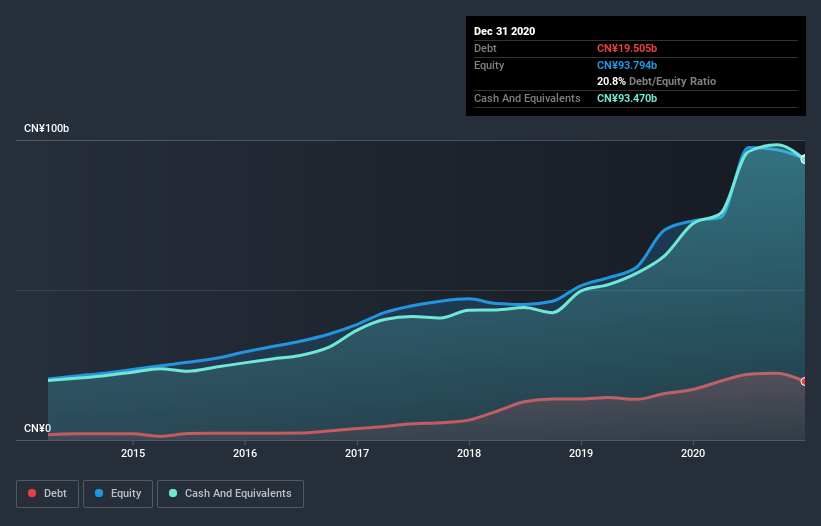NetEase (NASDAQ:NTES) Has A Rock Solid Balance Sheet
Howard Marks put it nicely when he said that, rather than worrying about share price volatility, 'The possibility of permanent loss is the risk I worry about... and every practical investor I know worries about.' When we think about how risky a company is, we always like to look at its use of debt, since debt overload can lead to ruin. As with many other companies NetEase, Inc. (NASDAQ:NTES) makes use of debt. But should shareholders be worried about its use of debt?
When Is Debt A Problem?
Debt is a tool to help businesses grow, but if a business is incapable of paying off its lenders, then it exists at their mercy. Part and parcel of capitalism is the process of 'creative destruction' where failed businesses are mercilessly liquidated by their bankers. However, a more common (but still painful) scenario is that it has to raise new equity capital at a low price, thus permanently diluting shareholders. Having said that, the most common situation is where a company manages its debt reasonably well - and to its own advantage. The first step when considering a company's debt levels is to consider its cash and debt together.
See our latest analysis for NetEase
How Much Debt Does NetEase Carry?
As you can see below, at the end of December 2020, NetEase had CN¥19.0b of debt, up from CN¥16.8b a year ago. Click the image for more detail. But it also has CN¥93.5b in cash to offset that, meaning it has CN¥74.5b net cash.
How Strong Is NetEase's Balance Sheet?
According to the last reported balance sheet, NetEase had liabilities of CN¥46.7b due within 12 months, and liabilities of CN¥1.34b due beyond 12 months. Offsetting these obligations, it had cash of CN¥93.5b as well as receivables valued at CN¥4.58b due within 12 months. So it can boast CN¥50.0b more liquid assets than total liabilities.
This short term liquidity is a sign that NetEase could probably pay off its debt with ease, as its balance sheet is far from stretched. Simply put, the fact that NetEase has more cash than debt is arguably a good indication that it can manage its debt safely.
Fortunately, NetEase grew its EBIT by 5.4% in the last year, making that debt load look even more manageable. The balance sheet is clearly the area to focus on when you are analysing debt. But it is future earnings, more than anything, that will determine NetEase's ability to maintain a healthy balance sheet going forward. So if you're focused on the future you can check out this free report showing analyst profit forecasts.
Finally, while the tax-man may adore accounting profits, lenders only accept cold hard cash. While NetEase has net cash on its balance sheet, it's still worth taking a look at its ability to convert earnings before interest and tax (EBIT) to free cash flow, to help us understand how quickly it is building (or eroding) that cash balance. Happily for any shareholders, NetEase actually produced more free cash flow than EBIT over the last three years. That sort of strong cash generation warms our hearts like a puppy in a bumblebee suit.
Summing up
While we empathize with investors who find debt concerning, you should keep in mind that NetEase has net cash of CN¥74.5b, as well as more liquid assets than liabilities. And it impressed us with free cash flow of CN¥22b, being 110% of its EBIT. So we don't think NetEase's use of debt is risky. The balance sheet is clearly the area to focus on when you are analysing debt. But ultimately, every company can contain risks that exist outside of the balance sheet. Case in point: We've spotted 2 warning signs for NetEase you should be aware of.
If you're interested in investing in businesses that can grow profits without the burden of debt, then check out this free list of growing businesses that have net cash on the balance sheet.
This article by Simply Wall St is general in nature. It does not constitute a recommendation to buy or sell any stock, and does not take account of your objectives, or your financial situation. We aim to bring you long-term focused analysis driven by fundamental data. Note that our analysis may not factor in the latest price-sensitive company announcements or qualitative material. Simply Wall St has no position in any stocks mentioned.
Have feedback on this article? Concerned about the content? Get in touch with us directly. Alternatively, email editorial-team (at) simplywallst.com.

 Yahoo Finance
Yahoo Finance 
